Medically reviewed and approved by a board-certified member
Zoology
COMPARATIVE ANATOMY: ARTERIAL SYSTEM OF RABBIT AND FROG
By BS MediaTwitter Profile | Updated: Monday, 22 May 2017 18:04 UTC

| SIMILARITIES AND DIFFERENCES OF ARTERIAL SYSTEM OF MAMMAL (RABBIT) AND AMPHIBIAN (FROG) | |
|
Frog - Arterial System |
|
| 1. The blood to different parts of the body and lungs is supplied by carotico-systemic trunk and pulmonary aortaoriginating from left ventricle and right ventricle respectively. | 1. The blood to different parts of the body and lungs is supplied by three aortic arches (carotid, systemic and pulmocutaneous) oftrucus arteriosusoriginating from right side of the ventricle. |
| 2. The systemic gives a pair of coronary arteries to supply blood to the wall of heart. | 2. The blood to the wall of heart is supplied by coronary arteriesoriginating from carotid arches. |
| 3. An innominate artery arises from the carotico systemic arch. | 3. Innonimate artery is absent. |
| 4. The innominate artery gives three arteries namely right subclavian, right carotid and left carotid. The left sub-clavian arises from the carotico -systemic directly. | 4. The sub-clavians originate from the systemics on either side. Carotid arteriesare the branches of carotid arches on either side. |
| 5. The carotid artery is divided into externaland internal carotid arteries on either side. The external carotid artery supplies blood to the tongue, jaw muscles salivary glands and Internal carotid artery supplies blood to cranium and parts of the brain. | 5. The carotid arch is divided into i.Lingual artery to supply blood to the tongue and hyoid muscles and ii. Common carotid artery. The common carotid gives apalatine artery to the roof of buccal cavity and eyes and an Internal carotid-artery to the brain. |
| 6. Each sub-clavian is divided into 3 branches namely L Brachial artery to the fore limbs ii. Vertebral artery - to cavities of vertebrae, spinal cord and parts of brain and iii. Internal mammary artery to supply to thoracic and abdominal muscles. | 6. The sub-clavian artery supplies blood to the forelimbs of that side. |
| 7. The caratico-systemic trunk passes asdorsal aorta on the ventral side of vertebral column. | 7. The dorsal aorta is formed by rightsystemic only. |
| 8. Paired intercostal arteries from the dorsal aorta supply to the body wall | 8. Intercostal arteries are absent. |
| 9. A pair of phrenic arteries supply blood to the diaphragm. | 9. Phrenic arteries are absent. |
| 10. The coeliac artery originating from dorsal aorta supplies blood to the liver, spleen, stomach and duodenum. | 10. The left systemic after communicating with right systemic separates as coeliaco-mesenteric artery that divides into i.Coeliac and ii. Anterior mesenteric. Coeliac supplies to stomach and liver. |
| 11. The anterior mesenteric artery also originating directly from the dorsal aorta supplies to intestine, pancreas, caecum and colon. | 11. The anterior mesenteric supplies to duodenum, ileum, spleen and proceeds as posterior mesenteric. |
| 12. Posterior mesenteric artery supplies blood to colon and rectum. | 12. The posterior mesenteric arterysupplies blood to the large intestine. |
| 13. The dorsal aorta gives a pair of renal arteries to kidneys. | 13. Four pairs of renal arteries supply blood to the kidneys fromdorsal aorta. |
| 14. Gonadial arteries to the gonads originate directly from the dorsal aorta. | 14. Gonadial arteries originate from the first pair of renal arteries. |
| 15. A.pair of lumbar arteries supply blood to the dorsal body wall from dorsal aorta. | 15. Lumbar arteries are absent. |
| 16. Caudal artery supplies to the tail | 16. Caudal artery is absent. |
| 17. Iliolumbar artery arises from the common iliac and supplies to dorsal body wall. The common iliac divides into i. Internal iliac - to pelvis and ii. External iliac - to the hind limb. * A vesicular arises from common iliac to supply to urinary bladder. The external iliac terminates as femoral artery in the hind limb of that side. | 17. Each iliac artery gives rise to i. vesiculo-epigastrictothe urinary bladder and ii.femoral artery to the outer part of thigh. The rest of iliac terminates as sciatic artery to supply to the hind limb. |
Tags:
End of the article